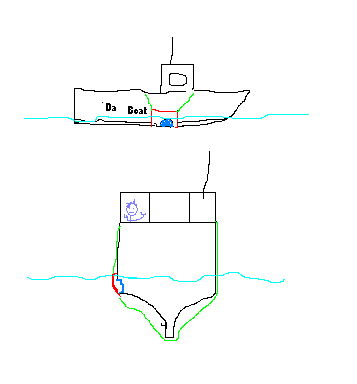
*Damage Control*
Disclaimer: I can't guarantee that these procedures will save your boat. Depending on cirumstances and conditions, these procedures may not be effective. Other circumstances and conditions may permit these procedure to work just fine. This is not official text by any means. It is meant for informational/educational purposes only.
Damage Control (DC) is exactly that, controlling damage. In the marine world boats sometimes become damaged in groundings, collisions, or from striking submerged objects. These mishaps result in a holed, cracked or a weakened hull. If the hull has been damaged to the extent that water is entering the interior of the boat, it must be plugged or patched to keep the boat afloat.
Plugs: The simplest method to stop up a small hole in wooden or metal hull is to insert a plug or plugs. Plugs are usually made of soft wood such as pine or fir. They are in the shape of an icecream cone and are also in different sizes. Use plugs individually or in combination with other materials to make a better fit.
Wedges: The simple method to plug a crack in a wooden or metal hull is with a wedge. Wedges are usually made of soft wood also. They look just like an ordinary wedge and also in various sizes.
Note on fiberglass hulls: Trying to drive a plug or wedge into a fiberglass hull will most always make the crack/hole bigger. You're better off to go with a collision patch.
Patching: patching holes is another good method to stop flooding. A collision mat is used in this case, it's made out of canvas or vinyl. A blue tarp or something similar will also work.
DC KIT
In the coast guard every standard boat is required to carry a DC kit. Kits typically contain: assorted sized plugs, assorted sized wedges, assorted hoseclamps(with screwdriver), hacksaw, small wood saw, small pieces of firehose(chaffing gear), oakum, small diameter marlin line, 20+ feet of manila line, wooden mallet, 4*4 piece of rubber, 4*4 piece of light canvas. Some units have added onto their kits. With these few basic simple supplies, odds are that you can keep a boat afloat unless there is very substantial damage that you don't have the equipment to handle.
To use a collision mat: You have a breech in your hull. The hole is approximately 2' by 3' big. Too big to plug. Here's how it's done.
1. Tie four lines to the corners of the patch.
2. Position the patch by dropping the patch over the bow.
3. Have someone walk down each side of the boat, two of the lines for each person.
4. Slide the patch along the bottom of the boat.
5. Once the patch covers the hole, secure the four lines topside. The pressure of the water against the patch will also help to hold it in place.
No, I'm not a good artist....

Basic plugging: You have a small breech in your hull. A circular hole approximately 5" diameter.
First of all, take something, anything and plug the hole to atleast slow the water flow down. Use a larger sized plug, but not too big and wrap it in oakum. Insert the plug into the hole and use a wooden mallet or something similar to seat it in. If you have a good fit there will be little to no water leaking in. The oakum will help seal the plug to the hull. Once the plug is installed, monitor it to make sure it doesn't fall out.
Basic wedging: You have a small breech in your hull. A crack approx. 6" long by 3" wide.
Again, take something and shove it in there to slow the water flow. If you have a single wedge that will fit in the crack, wrap it in oakum and hammer it in. If you only have small wedges, you can very easily double, triple, quadruple them up. Wrap them all in oakum. Loosely insert one, insert the other, and then insert another if needed. Hammer them all in together. Don't insert them too tight or you may make the crack bigger, just enough to atleast slow the water flow and enough so they won't fall out. Keep in mind that anytime you're trying to plug a hole below the waterline, you have to be moving quick.
These simple things may just save your life.
Semper ParatusAll materials at this site not otherwise credited are Copyright © 1996 - 2002 Trip Williams. All rights reserved. May be reproduced for personal use only. Use of any material contained herein is subject to stated terms or written permission.